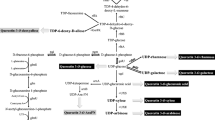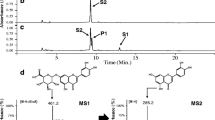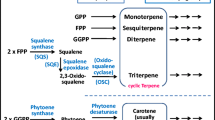Abstract
(2S)-Flavanones (naringenin and pinocembrin) are key intermediates in the flavonoid biosynthetic pathway in plants. Recombinant Escherichia coli cells containing four genes for a phenylalanine ammonia-lyase, cinnamate/coumarate:CoA ligase, chalcone synthase, and chalcone isomerase, in addition to the acetyl-CoA carboxylase, have been established for efficient production of (2S)-naringenin from tyrosine and (2S)-pinocembrin from phenylalanine. Further introduction of the flavone synthase I gene from Petroselinum crispum under the control of the T7 promoter and the synthetic ribosome-binding sequence in pACYCDuet-1 caused the E. coli cells to produce flavones: apigenin (13 mg/l) from tyrosine and chrysin (9.4 mg/l) from phenylalanine. Introduction into the E. coli cells of the flavanone 3β-hydroxylase and flavonol synthase genes from the plant Citrus species led to production of flavonols: kaempferol (15.1 mg/l) from tyrosine and galangin (1.1 mg/l) from phenylalanine. The combinatorial biosynthesis of the flavones and flavonols in E. coli is promising for the construction of a library of various flavonoid compounds and un-natural flavonoids in bacteria.




Similar content being viewed by others
References
Dixon RA, Steele CL (1999) Flavonoids and isoflavonoids—a gold mine for metabolic engineering. Trends Plant Sci 4:394–400
Hwang EI, Kaneko M, Ohnishi Y, Horinouchi S (2003) Production of plant-specific flavanones by Escherichia coli containing an artificial gene cluster. Appl Environ Microbiol 69:2699–2706
Kaneko M, Hwang EI, Ohnishi Y, Horinouchi S (2003a) Heterologous production of flavanones in Escherichia coli: potential for combinatorial biosynthesis of flavonoids in bacteria. J Ind Microbiol Biotech 30:456–461
Kaneko M, Ohnishi Y, Horinouchi S (2003b) Cinnamate: coenzyme A ligase from the filamentous bacterium Streptomyces coelicolor A3(2). J Bacteriol 185:20–27
Lukaèin R, Wellmann F, Britsch L, Martens S, Matern U (2003) Flavonol synthase from Citrus unshiu is a bifunctional dioxygenase. Phytochemistry 62:287–292
Martens S, Forkmann G, Matern U, Lukaèin R (2001) Cloning of parsley flavone synthase I. Phytochemistry 58:43–46
Martens S, Forkmann G, Britsch L, Wellmann F, Matern U, Lukaèin R (2003) Divergent evolution of flavonoid 2-oxoglutarate-dependent dioxygenases in parsley. FEBS Lett 544:93–98
Miyahisa I, Kaneko M, Funa N, Kawasaki H, Kojima H, Ohnishi Y, Horinouchi S (2005) Efficient production of (2S)-flavanones by Escherichia coli containing an artificial biosynthetic gene cluster. Appl Microbiol Biotechnol DOI 10.1007/s00253-005-1916-3
Moriguchi T, Kita M, Tomono Y, Endo-Inagaki T, Omura M (2001) Gene expression in flavonoid biosynthesis: correlation with flavonoid accumulation in developing citrus fruit. Physiol Plant 111:66–74
Moriguchi T, Kita M, Ogawa K, Tomono Y, Endo T, Omura M (2002) Flavonol synthase gene expression during citrus fruit development. Physiol Plant 114:251–258
Sambrook J, Russell DW (2001) Molecular cloning: a laboratory manual, 3rd edn. Cold Spring Harbor Laboratory Press, Cold Spring Harbor, NY
Schröder J (1997) A family of plant-specific polyketide synthases: facts and predictions. Trends Plant Sci 2:373–378
Watts KT, Lee PC, Schmidt-Dannert C (2004) Exploring recombinant flavonoid biosynthesis in metabolically engineered Escherichia coli. ChemBioChem 5:500–507
Weisshaar B, Jenkins GI (1998) Phenylpropanoid biosynthesis and its regulation. Curr Opin Plant Biol 1:251–257
Winkel-Shirley B (2001) Flavonoid biosynthesis. A colorful model for genetics, biochemistry, cell biology, and biotechnology. Plant Physiol 126:485–493
Acknowledgements
This work was supported by the Japan Foundation of Applied Enzymology, by the BioDesign Program of the Ministry of Agriculture, Forestry, and Fisheries of Japan, and by a Grant-in-Aid for Scientific Research on Priority Areas from Monkasho.
Author information
Authors and Affiliations
Corresponding author
Rights and permissions
About this article
Cite this article
Miyahisa, I., Funa, N., Ohnishi, Y. et al. Combinatorial biosynthesis of flavones and flavonols in Escherichia coli . Appl Microbiol Biotechnol 71, 53–58 (2006). https://doi.org/10.1007/s00253-005-0116-5
Received:
Revised:
Accepted:
Published:
Issue Date:
DOI: https://doi.org/10.1007/s00253-005-0116-5




